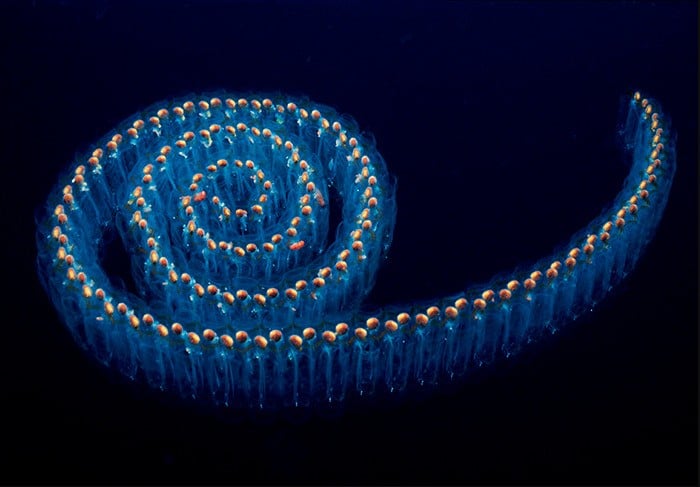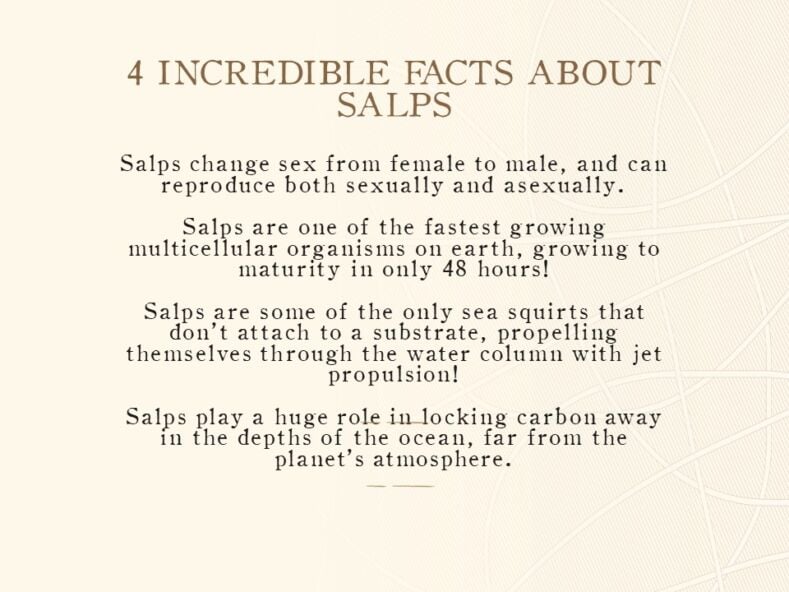In the final week of April, we experienced an unusual and little-known phenomenon while snorkeling on our house reef – a salp bloom. As we swam out to the drop off here at Gili Lankanfushi, we became enveloped in a thick cloudy soup of tiny marine animals known as salps. The small jellylike creatures brushed down our arms and legs, and you could catch them in your hands. Luckily, unlike jellyfish, these creatures, which are a type of “sea squirt” or “tunicate,” don’t deliver a nasty sting, but are totally harmless!
Salps are small cuboids or barrels of jelly with a prominent red sphere within their clear bodies (which is their gut!). There are around 40 different species of salp worldwide that come in all different shapes and sizes. Unlike other sea squirts, which usually anchor themselves to reef, rock or jetty, salps are planktonic. This means that they drift within the water column.

Individual salps can float freely in the ocean and range from 0.5 cm to 20 cm in size. These individuals are genderless and can asexually produce long chains of linked clones that can reach many meters in length! Within these chains, the individual salp are all female at first. These female salps can then mate with males (sexual reproduction) to produce one single embryo each. These embryos develop into genderless individuals that are then released into the water to reproduce asexually again. Meanwhile, after giving birth, the mothers switch gender to male. This allows them to go on to fertilize future chains of females.
The bloom that we encountered here at Gili Lankanfushi was of salp chains that were only a few centimeters long, with individuals under 1 cm in size. However, it’s unlikely that they will have stayed this size for long! Salps are actually one of the fastest growing multicellular organisms on the planet. Salps can grow to maturity in only 48 hours and can increase their body length by up to 10% per hour [1].

Salps move through the ocean via jet propulsion, sucking water in through an entrance siphon on one side of their body and using muscle contraction to push the water out through an exit siphon on the other side. This not only allows for movement but also enables them to filter feed on plankton and algae. Their ability to grow and consume nutrients at such a high rate makes salps incredibly important for carbon and nutrient cycling in the oceans. They help to carry nutrients between different ocean depth zones, making them available to different types of ocean creature.
It is also in this way that salps are some of the unsung heroes of climate change. Salps feast on algae and other phytoplankton, which convert carbon dioxide into carbon-based sugars using sunlight (photosynthesis). Thus, when salps eat these algae and other phytoplankton, they digest and assimilate this carbon within their own bodies. This means that salp droppings are highly rich in carbon and sink very quickly to the ocean floor. They can fall at rates of 1 km per day. Further, when salps die, the carbon they carry within their bodies also sinks to the ocean floor. This carbon then gets stored in the seafloor sediment and is locked away from the atmosphere so that it can’t cause further atmospheric warming. According to a study published in 2020 [2], the global population of salps, jellyfish and other jelly-like creatures could cause as much as 2 billion tonnes of carbon to fall to the seafloor, and be “safely stored” every year. So, if you ever find yourself in a plankton bloom, or encountering huge chains of jelly in the sea, look closely, and remember the amazing abilities held by these weird and wonderful creatures!
